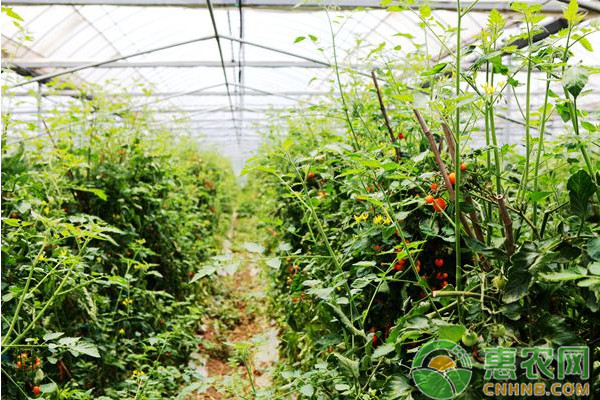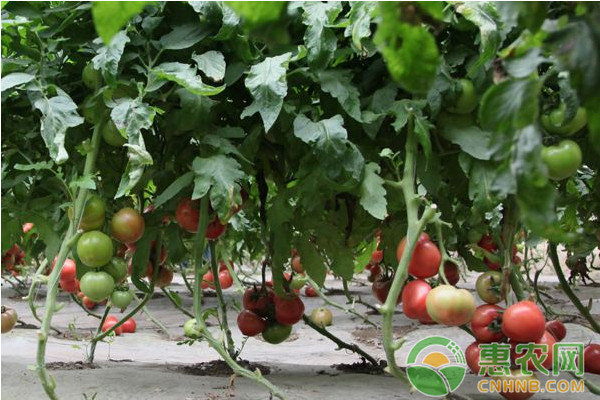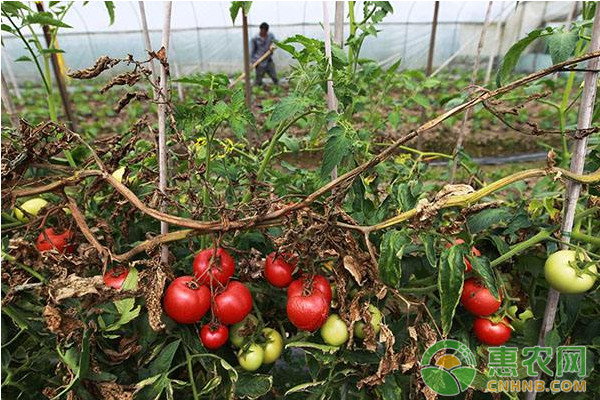Talking about the green prevention technology of the main diseases of tomato in greenhouse
Today, I will talk about the main diseases in the greenhouse tomatoes and the green prevention and control technologies of these diseases. Only by controlling the disease from the source, the yield and quality of greenhouse tomatoes will increase. 1 tomato early blight 1.1 Symptoms Early blight can occur throughout the growing season of tomatoes. The pathogen mainly invades the leaves, stems, fruits and other parts, and the leaves and stems and leaves are most susceptible to disease. The symptoms begin to appear from the lower leaves and gradually expand upward. Small brown spots appeared on the initial leaves, and then expanded into a nearly round or irregularly shaped gray-brown lesion with a dark brown concentric pattern. The path of the stems and leaves is bifurcated, the lesions are round or diamond-shaped, slightly concave, and there are also dark brown concentric circles, and the plants are easily broken from the disease. The fruit is killed, starting from the fruit pedestal, the lesion is round or elliptical, concave, like a black plaster block, and a black mold layer grows on the lesion in a humid environment. 1.2 Incidence conditions High temperature and high humidity environment are prone to disease. When the temperature is above 25 °C and the humidity is above 70%, the disease is serious. Soils with poor soil fertility and extensive management are seriously affected. 1.3 Green control technology 1.3.1 Rotation and non-solanaceae crops can be used for more than three years to reduce the incidence. 1.3.2 Scientific management Select disease-free and strong seedlings for colonization, spray prevention before planting, and bring medicine into the shed. Under-film drip irrigation or tube irrigation, reduce the humidity in the shed; rationally apply nitrogen and phosphorus fertilizer to avoid partial application of nitrogen fertilizer; timely clean up the old leaves and diseased leaves under the plant to promote ventilation and light transmission in the field. 1.3.3 At the beginning of the disease prevention and treatment, spray 50% isocarbazone wettable powder 1000 times solution, 72% cream urea manganese zinc wettable powder 600 times liquid, 65% metformin WP 1200 times liquid, 7~ 8d spray once, even spray 2 or 3 times. 2 tomato late blight 2.1 Symptoms Late blight mainly affects the leaves and fruits of tomato, and can also infect stems. The onset of the leaves starts from the tip of the leaf and the edge of the leaf. The early stage of the lesion is dark green water-immersed, and then turns brown. When wet, the white mold layer grows at the border of the leaf back disease. The lesions on the stalk are dark brown, slightly sunken, the edges are not clear, and a small amount of white mildew is found when wet. The fruit is easily damaged, and the oily immersed dark green lesions are formed near the fruit stalk. The gradient is dark brown or tan, and the edges form a cloud-like shape. The surface of the lesion becomes hard and a small amount of white mold can grow. 2.2 Incidence conditions The relative humidity in the shed is above 90%, and the temperature is 15 to 25 °C. The greenhouse tomato is densely planted, and the ventilation and light are poor. Especially in the rainy weather of about 7 days, late blight is easy to be popular. It is easy to develop a greenhouse in which tomatoes are not changed for years. 2.3 Green control technology 2.3.1 When planting cultivation and planting, select disease-free and strong seedlings. Before planting, concentrate the spray on the seedlings for protection; planting density is appropriate, timely pruning and snoring, remove the old leaves at the bottom, pay attention to ventilation and drainage; find diseased leaves, disease Fruit, diseased plants, immediately cleared. 2.3.2 In the early stage of the disease prevention and treatment, timely spraying and control, 25% metalaxyl WP 400 times solution, 58% toxic poison, manganese zinc wettable powder 500 times liquid, 70% mancozeb WP 500 Spray such as liquid, spray once every 7 to 8 days, and spray 2 to 3 times. 3 tomato leaf mold 3.1 Symptoms of the disease Leaf mold is mainly harmful to leaves, and sometimes it can damage stems, flowers and fruits. After the leaves are damaged, yellow-green spots appear on the front of the leaves, and gray-white mildew is formed on the lesions on the back of the leaves, and then becomes pale brown or dark brown. When the disease is serious, the whole plant leaves can be curled and dried in yellow and brown. The fruit is damaged, and a round or irregular black lesion is often formed in the pedicle, and then gradually hardens and dents, losing the edible value. 3.2 Incidence conditions When the relative humidity in the greenhouse is higher than 90%, or when the humidity is high in the cloudy day, it is easy to develop, but the sunny day is sufficient, and the temperature of the shed is above 30 °C, which can inhibit the spread of the disease. 3.3 Green control technology 3.3.1 Do a good job in fitness and timely rotation, use timely drip irrigation to reduce the humidity inside the shed; scientific fertilization to enhance plant disease resistance. 3.3.2 In the early stage of drug control, timely spray 25% azoxystrobin suspension 2000 times solution, 30% benzyl propionazole emulsion 4000 times solution, 10% high water dispersion granule 1500 times solution, etc. Alternate use, spray once every 7~10d, even spray 2~3 times. 4 tomato gray mold 4.1 Symptoms Gray mold is mainly harmful to fruits, and can be harmed from young fruit to large fruit. The fruit surface near the fruit stalk first appeared pale yellow water-immersed lesions, the edges were not clear, and there was no fixed shape. The fruit stalks were radiated to the fruit surface, and the lesions were soft and rotted. A layer of gray mold. The leaves are damaged, and the initial tip of the leaf is a "V" shaped lesion, which gradually turns from grayish white to brown and dry, and the ring pattern is faintly visible. Petiole and stem are sometimes also victimized. 4.2 Incidence conditions Low temperature, high humidity or excessive planting density, poor ventilation, and even rainy weather, the incidence is heavy. The optimum temperature for the development of pathogens is 16 to 23 ° C, above 25 ° C, which is not conducive to the spread of disease. The relative humidity continues to be above 90%, and the disease is highly prone to epidemics. When the disease is serious, the stems and leaves are dead and a lot of burnt and rotten fruits are directly affected, which directly affects tomato yield. 4.3 Green control technology 4.3.1 Agricultural control to strengthen the management of fertilizer and water, so that the plant grows vigorously, prevent premature aging and wounds caused by various factors; the shed should be ventilated and light-transmitted to ensure that the temperature inside the shed is not too low; using mulching, drip irrigation under the membrane, reducing the shed Humidity; after harvesting, thoroughly clear the garden, dry the soil, and reduce the source of the bacteria. 4.3.2 At the beginning of the disease prevention and treatment, 50% speed Keling WP 1500 times solution, 65% metalaxyl WP 1000 times solution, 50% chlorhexidine WP 1200 times solution, etc., 7~ 10d spray once, even spray 3 to 4 times, the above drugs are used alternately. 4.3.3 Strengthening inspection and testing capacity building The construction of the county agricultural product quality inspection and testing station as the main body, based on the township testing station, with the main producing areas, pollution-free bases, large and medium-sized leading enterprises, wholesale market quality testing stations (points) as a supplement to the county's agricultural product quality testing The inspection system will speed up the modernization of testing methods and improve testing capabilities and levels. Strive to build one county-level agricultural product quality safety supervision and inspection station, 44 township pesticide residue rapid detection rooms, 35 village-level pesticide residue rapid detection rooms, and 20 enterprise rapid detection rooms by 2020. Normalization and qualitative monitoring are carried out. The county-level monitoring is no less than 600/month, and the township is no less than 60/month. The types of monitoring cover fruit trees, vegetables, fungi, meat, eggs, milk and grain and oil products, covering all townships, key villages and major farming bases. The above is the whole content of the green disease prevention and control technology for the main diseases of greenhouse tomatoes. You can learn more from the slum friends. our NBR Examination, Chemotherapy, and Food Grade products are being well established in both US and Europe markets. food grade nitrile gloves,household gloves,safety gloves,disposable nitrile gloves,food gloves Jiangsu Yanfang Medical Technology Co.,Ltd. , https://www.yanfangchina.com


